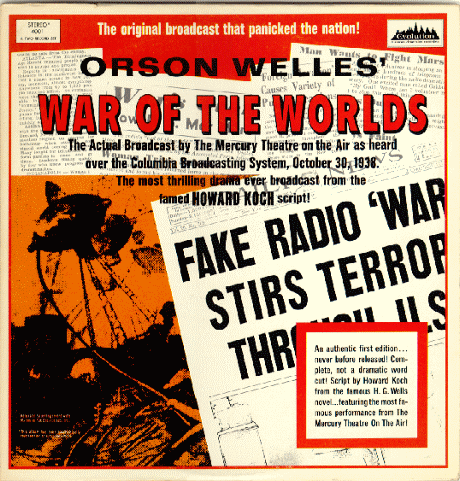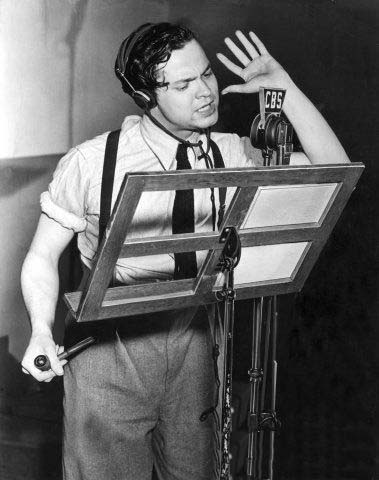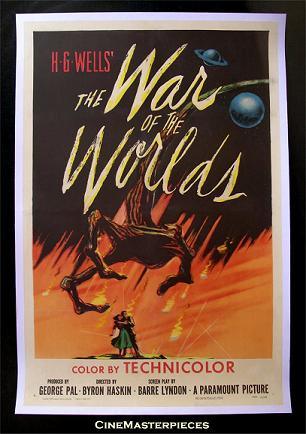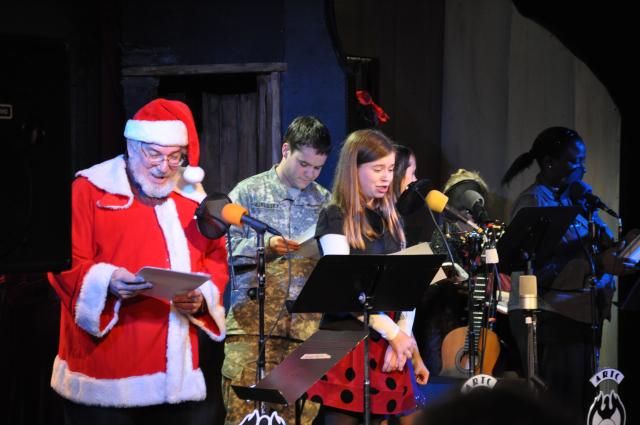
Ethan Hurlburt, Sara Lozano, Maddie Dill and Laurice White in ARTC's 2008 production of AN ATLANTA CHRISTMAS. Photo credit: Caran Wilbanks
Much is made of the visual aspects of the holidays—all the lights, the snow, Santa in his suit of red. But with, the Atlanta Radio Theatre Company (ARTC)’s AN ATLANTA CHRISTMAS, the sounds of the season take center stage Dec. 10, 11, 17 and 18 at the Academy Theatre in Avondale Estates. In the spirit of the season, tickets cost whatever you can afford, even if that means free, so it’s a great opportunity to experience the Noel nostalgia of not just city holiday traditions but also an enjoyable performance art form that came close to going the way of the dinosaur but is now enjoying its own Retro revival. However, ATLRetro hopes you will give what you can to support this hardworking community theater in tough economic times, and ARTC is donating 25% of all ticket sales to the Center for the Visually Impaired.
Back in the 1930s and ‘40s families gathered together in the evenings to listen to the radio. Much more than music, less-than-funny deejays and pontificating talk show hosts, radio channels used to air a wide variety of programs from adventure serials with iconic characters like THE SHADOW to dramatic productions like the infamous WAR OF THE WORLDS broadcast narrated by Orson Welles, soap operas like STELLA DALLAS to comedies to FIBBER, MCGEE & MOLLY. But with the advent of TV, radio theater became all but a lost art form.
 ARTC was one of the first of a handful of companies around the country who have embraced radio theatre, and for more than two decades, its members have worked passionately to afford it a new lease on life as a live performance medium. While listeners still use their imagination to visualize the action, the live stagings, at theaters and also often at science-fiction conventions, afford a behind-the-scenes peek into what it would be like to visit a vintage radio station. Actors read their lines live, and sound effects and music are added on the spot. Of course, you can also purchase recordings of ARTC productions, which run the entire gamut from dramas to comedies to new takes on the old SF adventure serials, to further take yourself back to the golden age of radio. Seems like it’d be bound to make that long roadtrip home for the holidays go a little faster, and once you get there, wouldn’t it be nice to get everyone to be quiet, gather around the fireplace and listen to them, too?
ARTC was one of the first of a handful of companies around the country who have embraced radio theatre, and for more than two decades, its members have worked passionately to afford it a new lease on life as a live performance medium. While listeners still use their imagination to visualize the action, the live stagings, at theaters and also often at science-fiction conventions, afford a behind-the-scenes peek into what it would be like to visit a vintage radio station. Actors read their lines live, and sound effects and music are added on the spot. Of course, you can also purchase recordings of ARTC productions, which run the entire gamut from dramas to comedies to new takes on the old SF adventure serials, to further take yourself back to the golden age of radio. Seems like it’d be bound to make that long roadtrip home for the holidays go a little faster, and once you get there, wouldn’t it be nice to get everyone to be quiet, gather around the fireplace and listen to them, too?
ATLRetro asked David Benedict, vice president of ARTC and co-director/coproducer of AN ATLANTA CHRISTMAS by Thomas Fuller, why the holidays are such a perfect time to enjoy radio theater and why it should be preserved in a CGI-laden visual age.
Without giving away too much, what’s the basic story behind AN ATLANTA CHRISTMAS?
The most basic summary I can give is that AN ATLANTA CHRISTMAS is about Christmas inAtlanta. It is a series of short vignettes that detail how our unique city has celebrated the season throughout the years, beginning with the first appearance of the Christmas tree and continuing to modern day. It is framed by the image of a family gathered together for the holiday, passing their own memories along to their children.
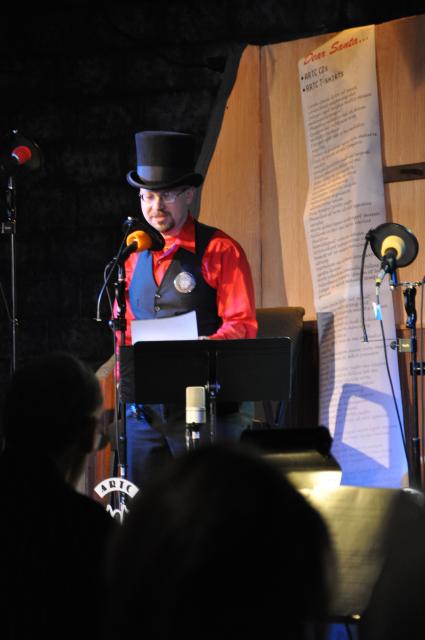
David Benedict introduces AN ATLANTA CHRISTMAS. Photo Credit: Caran Wilbanks.
This is ARTC’s 12th year performing AN ATLANTA CHRISTMAS, so it’s becoming an Atlanta Christmas tradition itself. Why do you think this show has such enduring popularity?
Although the world has gotten smaller, people still hold a strong connection with their local community. AN ATLANTA CHRISTMAS puts a sharp focus on the way the holiday and the way we as a city celebrate it has changed throughout the years, while also highlighting the things that remain constant: family, hope, renewal, and giving.
Why does the radio theater format work so well for this production?
Christmas, along with Halloween, are extremely imaginative times of the year and lend themselves well to the format. Radio theatre, or audio drama, calls upon the audience to use their imaginations to envision for themselves the settings and the appearances of the characters. We facilitate this through our use of well-written scripts, sound effects and music. During Christmas, people are more in tune with their imaginations, which is exhibited through our common references to elves at the North Pole, winter wonderlands and flying reindeer. These things, as well as the general joy and goodwill of the season, resonate extremely well with radio theatre.
Do you have a favorite scene in AN ATLANTA CHRISTMAS—or should we say “segment”—and why?
It’s so hard to pick one. Thomas Fuller was a master at painting visual tableaus with nothing more than a well-chosen word or two. But if I had to pick just one, I would probably go with Davy Crockett and Me, which tells the story of two brothers who desperately want Davy Crockett’s coonskin caps from the classic TV show. The piece makes a point of contrasting the black and white television of the time with the colorful lights and decorations of the holidays that really stands out in my mind. Plus, I’ve performed it with my good friend Hal Wiedeman for the last few years. We’ve grown so used to the roles that we’ve taken turns being the other brother a couple of times, and we joke that we’re going to give the director a heart attack one year and try switching roles in the middle of the performance!
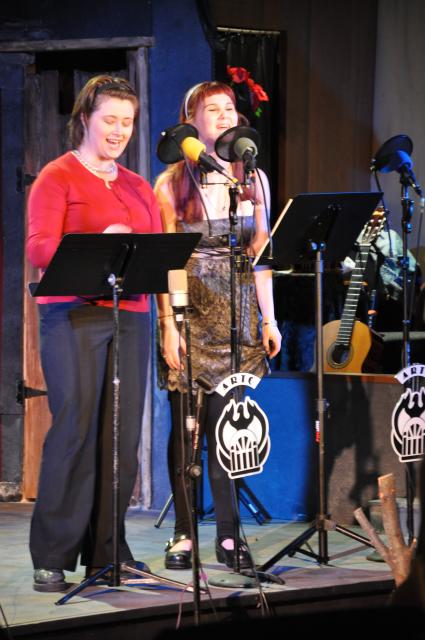
Jayne Lockhart and Rachel Pendergrass perform in the 2008 ARTC production of AN ATLANTA CHRISTMAS. Photo credit: Caran Wilbanks.
ARTC has performed many plays by Thomas Fuller, and he was a key player for many years with ARTC. Can you share a few words about his impact on ARTC and why ARTC continues to perform so many of his works?
It is hard to overstate the importance of Thomas Fuller to ARTC and the loss we felt at his passing. Thomas had a complete grasp of the potential of radio theatre. He wrote compelling characters, he understood the medium for which he was writing, and he could use sound very effectively. Moreover, though, he was constantly pushing us to greater excellence. He would take new writers and offer them advice, encouragement, and help them make the most of their story. As for why we continue to perform his work, I think you only have to listen to one of his plays to know that. His work stretches us, and as we continue to develop new writers, we often use Thomas’s work as the benchmark against which new work can be measured and the heights they can strive for. One of our (relatively) new writers, Kelley S. Ceccato, has taken to this challenge and is currently writing some of our most immersive, lushly soundscaped work.
It’s pretty unconventional and some would say courageous if you actually want to cover expenses to have tickets that are “name your price.” Why do you do that, and what guidelines should people use to decide what to pay?
Radio theatre was largely abandoned in the United States back in the 1940s and 1950s, and although it is enjoying a comeback of sorts in the modern Internet age, people still don’t often think of it as a viable entertainment medium. And yet when people are exposed to our work and the work of other radio theatres around the world, they find the medium very enriching. At this time of year, we want to give the gift of imagination to people who might not otherwise have the financial capability to come to live theatre. In this economy, leisure expenses are not always affordable, but we feel that at this time of year we have something to offer and want as many people as possible to be able to receive and enjoy the gift of audio drama that we have to give.
In addition to that, we are also making a donation of 25% of all ticket sales to the Center for the Visually Impaired. We feel it’s a very natural fit with this particular nonprofit, and we’ve made a donation to them for several years now as a part of this show. Patrons who are not sure how much they should pay for a ticket should do what feels most comfortable to them. We invite people to come see the show for as little as $0, but we encourage them to pay as much as they like. For the truly undecided, we have a suggested price of $10.
Radio theater isn’t thought of as a visual medium, so why is it so much fun to see it performed live?
Live theatre is always an adventure, and even though we aren’t doing re-creations of the classic radio dramas, preferring to write our own material and do original adaptations, there’s still a nostalgia appeal to seeing a group of actors creating a scene right in front of you using nothing but their voices and the audience’s imagination. There’s also an immediacy that’s difficult to re-create with a recording. How many times have you stopped and listened to a song you heard on the radio even though you could have listened to it on your mp3 player any time you wanted? Lastly, there’s the controlled environment of the theatre itself. Life moves fast these days and even in the car it can be difficult to tune out the distractions and give your imagination free reign, and when you can do that, audio drama is at its best. Being in the theatre allows you to close your eyes and forget everything else except the picture being painted in your mind.
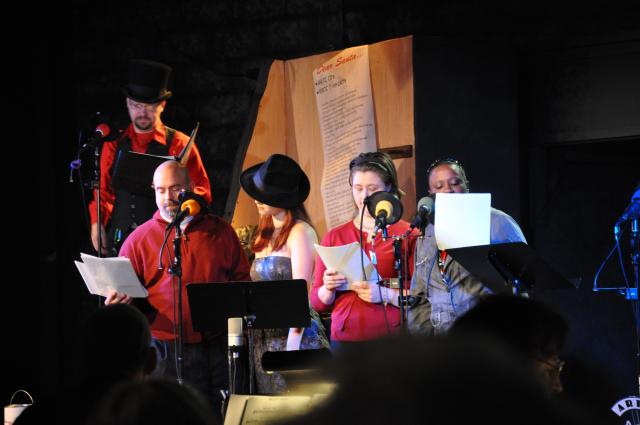
David Benedict, Bill Kronick, Rachel Pendergrass, Jayne Lockhart, Laurice White. Photo credit: Caran Wilbanks.
Plus, you never know what’s going to happen. One performance, which took place at Stone Mountain Park outdoors on a rainy day, called for a gunshot. We had a recorded sound effect ready to go for that, but as it turned out, there was someone at the festival demonstrating an actual black powder pistol and we worked it out with them to fire the gun on cue to add a little extra realism. We rehearsed it and it went off without a hitch, but during the performance the pistol misfired. You haven’t really lived until you’re in a situation where your sound effect hasn’t happened, there’s no way for it to happen, and your next line is supposed to be “She shot him!” As it turned out, on that particular occasion, he ended up poisoned.
How long have you been involved in ARTC, and what got you started?
I honestly don’t recall the exact date, but it’s been a really long time. Probably in the early to mid-‘90s. I’ve been a Dragon*Con attendee for many years and ARTC has performed at every Dragon*Con since the first one [1987], but somehow I hadn’t been to any of their shows. At one particular convention I happened across the name in the program book and made it a point to attend. As I recall the performance was COUNTRY OF THE BLIND or possibly THE ISLAND OF DR. MOREAU. Even though I had heard of radio drama before, I wasn’t aware that anyone was still performing it and certainly had never seen it done live. The entire experience just appealed to me, watching the sound effects being created on stage by the Foley crew, hearing the actors perform with as much passion and skill as any stage theatre or movie I had ever seen. I sought them out and got information about joining just as soon as the performance was over and have never looked back.

David Benedict. Photo credit: Ben Thompson, Alexandra Photography.
All of ARTC’s performers and technical team do this as a labor of love. What do you do as your day job, how did you personally get involved in ARTC, and why do you think the art form is worth preserving in a visual era?
Currently I work as an assistant manager in Guest Programs at the Georgia Aquarium. My team is the one you are most likely to interact with on a typical visit as we do exhibit interpretation and help people to better identify and understand the animals and conservation issues. As I mentioned, I first saw ARTC at Dragon*Con and was immediately drawn to them. I’ve actually gone through several jobs while sticking with ARTC the whole time and they have played a pretty major role in keeping me in the Atlanta area.
As Thomas Fuller once said, audio drama is probably the most plastic of all the art forms, which means that it can be molded by a skilled writer, sound designer and actors to be whatever you need it to be. Without suffering from the budget constraints that limit all but the most well-funded big studio filmmakers, audio dramatists can set whichever scene they want and there are dozens if not hundreds of people worldwide who are producing it in their own homes. It’s also a much more active art form. Well-crafted films can draw the audience in, but even the best films don’t really involve the audience the way audio drama can. By allowing them to set the scene, radio theatre makes the audience an essential part of the creative process and, we hope, encourages people to be more imaginative in their daily lives.
Many of your previous productions are available as recordings and make great gifts. What 3 productions do you recommend for someone wanting to get a good introduction to radio theater and ARTC, and how can one purchase recordings?
We have a wide variety of genres to choose from, so while we primarily serve the science fiction/horror/fantasy fan base, there’s really something for everyone and it depends on what you’re looking for. My personal favorites, though, are probably ALL HALLOWS MOON (an occult western) by Thomas E. Fuller, RORY RAMMER, SPACE MARSHAL: VOLUME 1 (a science fiction serial) by Ron N. Butler, and THE PASSION OF FRANKENSTEIN by Thomas E. Fuller. I think it’s also worth mentioning that AN ATLANTA CHRISTMAS is finally out on CD this year. One of the hazards of an all-volunteer small-press audio publisher is that sometimes things get caught up in the production cycle and never find their way out. AN ATLANTA CHRISTMAS took five years to complete, but I think the end result is totally worth it.
Recordings can be purchased on CD at our live performances or by mail order at www.artc.org. You can also download our material from Audible.com, iTunes and Amazon. And for those folks who aren’t sure what modern audio drama sounds like, they can check out our free monthly podcast at https://podcast.artc.org and download mp3s of our past live performances. We also appear on Aberrant Radio Monday nights at 8:30pm.
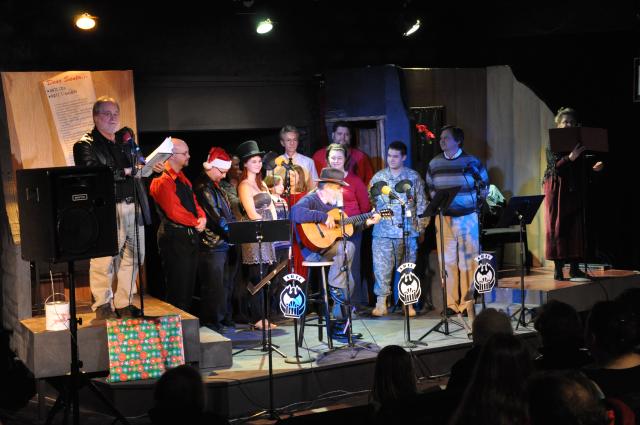
The cast of AN ATLANTA CHRISTMAS takes a curtain call, including Alton Leonard on guitar. Photo credit: Caran Wilbanks.
What’s next for ARTC in terms of live shows and new recordings in 2012?
Our next live performance after Christmas will be March 3 and 4 at the Academy Theatre where we’ll perform THE TIME MACHINE by H. G. Wells, adapted by Thomas E. Fuller. After that we’ll be at LibertyCon inChattanooga, TN, in July and Dragon*Con in September. In between we’ll take a short break to get back into the studio. Titles for the studio sessions are still being finalized and we still have a bunch of things left from our last studio session to finish up, but I’m thinking strongly of taking in THE TIME MACHINE, which used to be in the catalog but is now out of print, as well as THE COLOUR OUT OF SPACE by H. P. Lovecraft, adapted by Ron N. Butler, and if we get really ambitious we may attempt Brad Strickland‘s five-part adaptation of Robert Louis Stevenson‘s TREASURE ISLAND.
 THE DAY THE EARTH STOOD STILL (1951); Dir. Robert Wise; Starring Michael Rennie, Patricia Neal and Hugh Marlowe; Thursday, Oct 23 @ 7:30 p.m.; Cinevision Screening Room (visit the event page for address and directions); All tickets $10 (Atlanta Film Festival members save 20%); Tickets here; Trailer here.
THE DAY THE EARTH STOOD STILL (1951); Dir. Robert Wise; Starring Michael Rennie, Patricia Neal and Hugh Marlowe; Thursday, Oct 23 @ 7:30 p.m.; Cinevision Screening Room (visit the event page for address and directions); All tickets $10 (Atlanta Film Festival members save 20%); Tickets here; Trailer here. The film sees alien Klaatu (Michael Rennie) and his robot sentry Gort arrive on Earth to warn us against using our growing technological capabilities as a vehicle for greater violence, yet in a familiar turn, the benevolent visitor faces nothing but violence, resistance and persecution from the time of his arrival. The Klaatu-as-Christ metaphor (Klaatu—who also dies, is resurrected, and then ascends into heaven—even takes on the pseudonym of “Major Carpenter”) somehow escaped director Robert Wise’s view, but screenwriter Edmund North was clever enough to make the metaphor merely an emphasis of the movie’s universal themes. After all, the worries expressed in the movie knew no religious boundaries. We had just put the horrors of World War II to bed when the Cold War began, with tensions escalating between East and West. America had involved itself in the Korean War. Meanwhile, the US and USSR had started working seriously on competing space programs, and both sides had concerns that these programs would be of primary use as respective platforms of attack. All of these elements came together and formed the subtext of this film. And while the roots of the film’s themes are set deeply in the 1950s, the larger message of the movie—a call for understanding and cooperation between competing nations and ideologies—is something that never loses its poignancy.
The film sees alien Klaatu (Michael Rennie) and his robot sentry Gort arrive on Earth to warn us against using our growing technological capabilities as a vehicle for greater violence, yet in a familiar turn, the benevolent visitor faces nothing but violence, resistance and persecution from the time of his arrival. The Klaatu-as-Christ metaphor (Klaatu—who also dies, is resurrected, and then ascends into heaven—even takes on the pseudonym of “Major Carpenter”) somehow escaped director Robert Wise’s view, but screenwriter Edmund North was clever enough to make the metaphor merely an emphasis of the movie’s universal themes. After all, the worries expressed in the movie knew no religious boundaries. We had just put the horrors of World War II to bed when the Cold War began, with tensions escalating between East and West. America had involved itself in the Korean War. Meanwhile, the US and USSR had started working seriously on competing space programs, and both sides had concerns that these programs would be of primary use as respective platforms of attack. All of these elements came together and formed the subtext of this film. And while the roots of the film’s themes are set deeply in the 1950s, the larger message of the movie—a call for understanding and cooperation between competing nations and ideologies—is something that never loses its poignancy.





